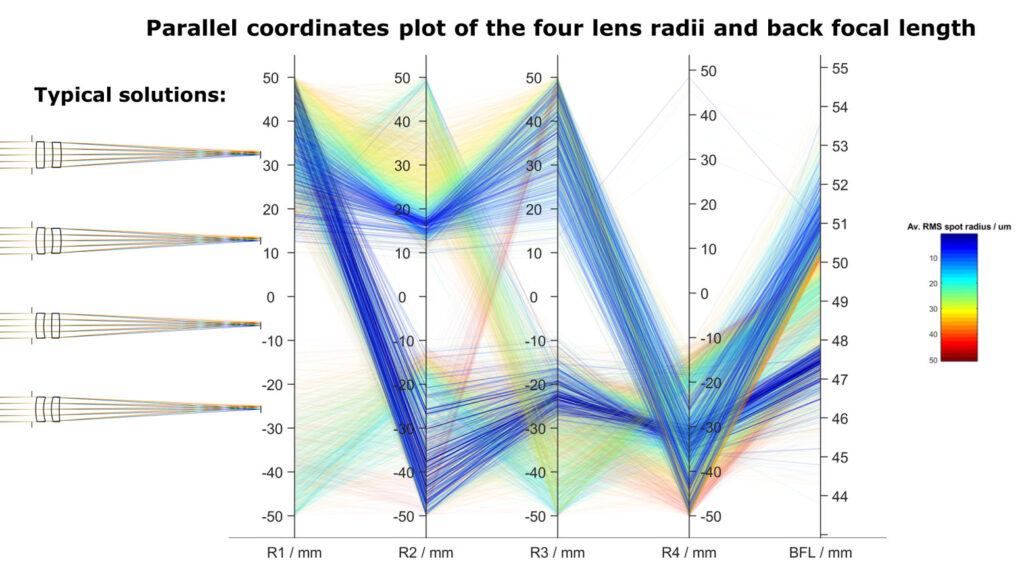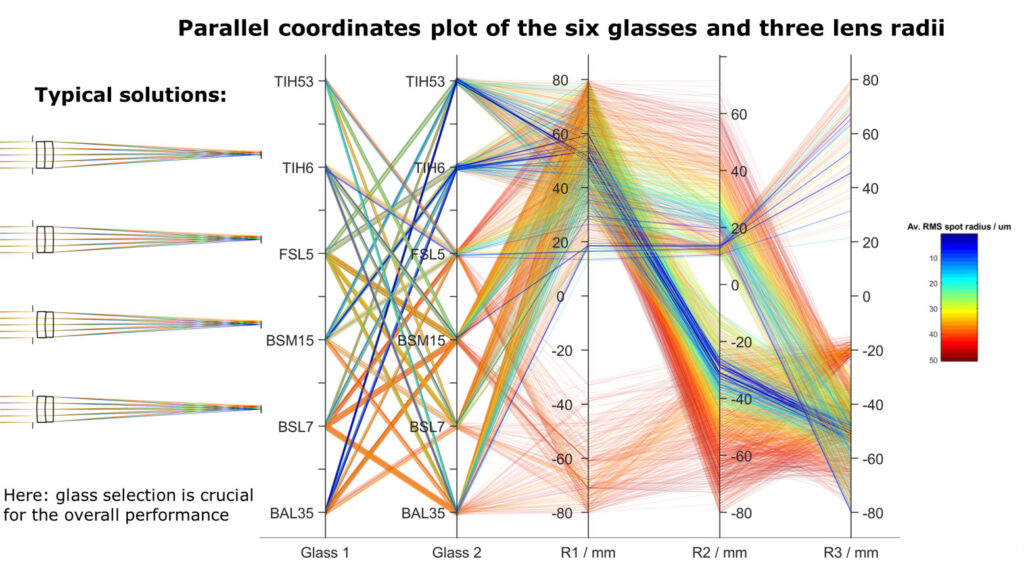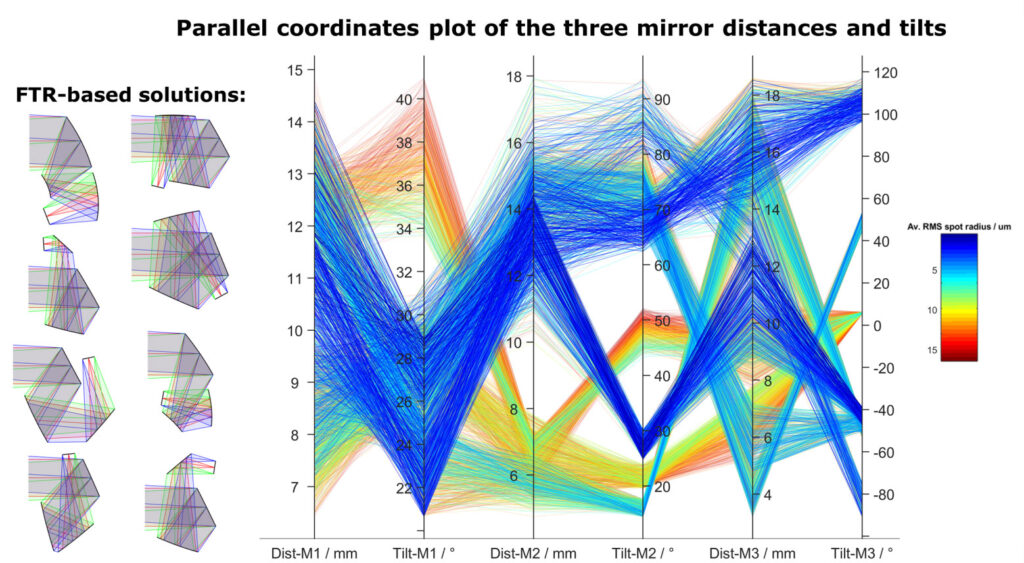Meet First Time Right
What sets it apart from traditional optical design?
Optical design challenges become complex fast with local minima and coupled parameters. Traditional optimization often only scratches the surface. We use fully analytic methods to reduce dimensionality upfront, enabling faster, deeper exploration with real-world constraints built in from the start.
Visualizing N-dimensional parameter spaces is a major challenge, even for relatively simple optical systems with just two or three lenses. These spaces are filled with numerous local minima, forming a complex landscape of hills and valleys shaped by the system’s design variables. A common mistake is to draw oversimplified conclusions from basic cases and assume that more complex systems behave like higher-dimensional versions of the same landscape. In reality, this assumption often breaks down.
In practical optical designs, the merit function becomes far more intricate. The resulting parameter landscape contains fine structural details and subtle irregularities. For example, what seems like the peak of a mountain may hide local dips that trap the design in highly suboptimal minima. Both local and global optimization strategies can only probe a limited portion of this high-dimensional space, constrained by finite time and computational resources. And this challenge intensifies when real-world constraints such as manufacturability, tolerances, and costs are added on top of the nominal design variables. This is precisely where our ‘First Time Right’ approach introduces a fundamental shift in methodology.
At the heart of our proprietary ‘First Time Right’ methodology is a radical reduction in parameter space dimensionality. Using fully analytic calculations, we determine the surface shapes that minimize and balance all aberrations by order. This reduces the initial N-dimensional design space to a much smaller, more manageable subspace. As a result, both local and global optimization methods, as well as machine learning tools can operate far more efficiently. This enables a deeper and more targeted exploration of the design space. Moreover, with fewer parameters to manage, we can account for real-world constraints, tolerances, and cost factors right from the start.
Exemplary visuals of design parameter spaces
A monochromatic f/8 two-lens objective
This basic optical system, with a 50 mm focal length and monochromatic correction at f/8, already features multiple local minima with varying performance. For simplification, both lens thicknesses and the spacing between them have been kept constant, yet the merit-function landscape already begins to reveal its complexity.
Even such a simple system highlights the challenges of navigating local minima and points to the limitations of traditional optimization in higher-dimensional spaces.
An achromatic f/8 doublet lens design
With a 50 mm focal length, six standard glasses, and all thicknesses fixed, this achromatic doublet already exhibits numerous local minima. Expanding the glass library further increases complexity, introducing a vast number of possible material combinations, and with it, many additional local minima.
'First Time Right' f/3 three-freeform mirrors
This design involves only six alignment variables, compared to over forty directly calculated surface coefficients. It clearly demonstrates the powerful dimensionality reduction achieved with ‘First Time Right’, enabling a thorough exploration of the design landscape.
Just imagine how complex the parameter space would be using conventional optimization with dozens of variables.
Key features of our 'First Time Right' method
Computations
Deterministic, fast, and robust all-analytic calculations
Surface Count
Fully flexible number of surfaces to fit design complexity
Materials & Shapes
Supports lenses and mirrors; spherical, aspherical, and freeform
Manufacturability
Built-in design considerations for reliable and efficient production
Selected references
Freeform imaging systems: Fermat’s principle unlocks 'First Time Right' design
F. Duerr, and H. Thienpont
Light: Science & Applications, Vol. 10, Article number: 95 (2021)
Automated freeform imaging system design with generalized ray tracing and simultaneous multi-surface analytic calculation
Y. Nie, D. R. Shafer, H. Ottevaere, H. Thienpont, and F. Duerr
Optics Express, Vol. 29, Issue 11, pp. 17227-17245 (2021)
First Time Right freeform optics: a systematic and highly effective tool to design imaging systems from scratch
F. Duerr, and H. Thienpont
Photonics Views, 18: 52-56 (2021)
Optical design of First Time Right imaging systems
F. Duerr and H. Thienpont
SPIE Optical Design and Testing XII, 123150E (2022)
Starting point generation for imaging systems under practical constraints
F. Duerr, O. Faehnle, and H. Thienpont
International Optical Design Conference, 127980R (2023)
Realizing ‘First Time Right’ designs of imaging systems using off-the-shelf lenses
A. Madrid-Sánchez, H.Thienpont, F. Duerr
SPIE Optical Systems Design Conference, 130191A (2024)
Fermat meets PanDao:
cost-efficient lens design
F. Duerr, O. Faehnle, E. Langenbach, H. Thienpont
SPIE Optical Systems Design Conference, 1301909 (2024)


